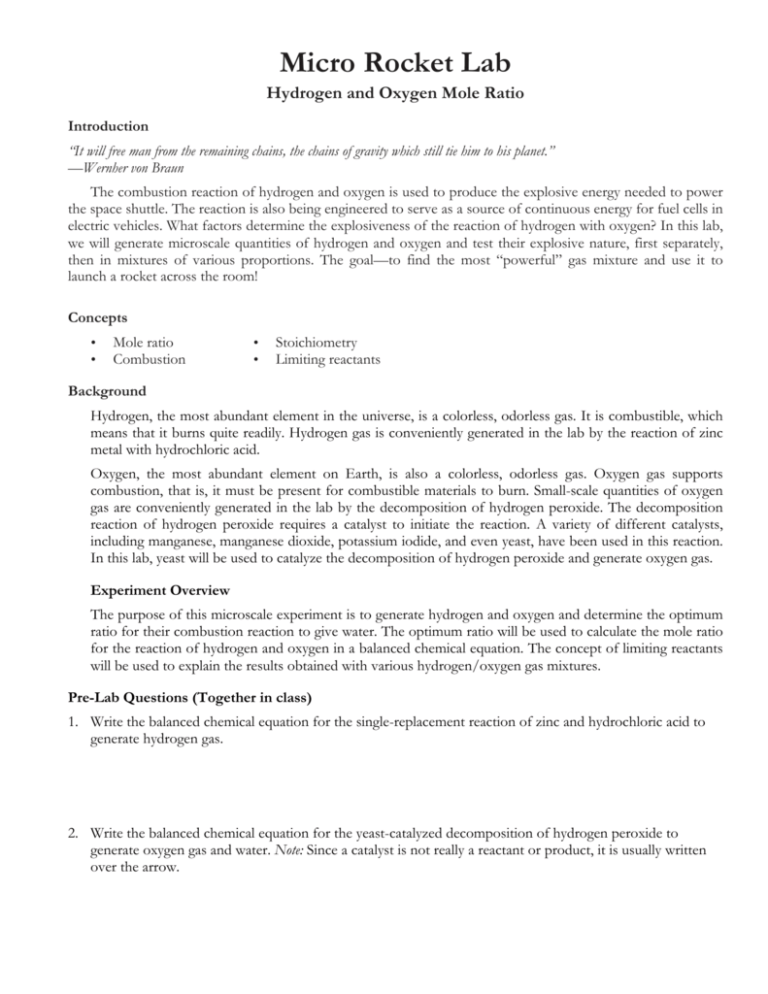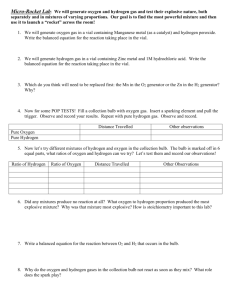
Micro Rocket Lab
Hydrogen and Oxygen Mole Ratio
Introduction
“It will free man from the remaining chains, the chains of gravity which still tie him to his planet.”
—Wernher von Braun
The combustion reaction of hydrogen and oxygen is used to produce the explosive energy needed to power
the space shuttle. The reaction is also being engineered to serve as a source of continuous energy for fuel cells in
electric vehicles. What factors determine the explosiveness of the reaction of hydrogen with oxygen? In this lab,
we will generate microscale quantities of hydrogen and oxygen and test their explosive nature, first separately,
then in mixtures of various proportions. The goal—to find the most “powerful” gas mixture and use it to
launch a rocket across the room!
Concepts
•
•
Mole ratio
Combustion
•
•
Stoichiometry
Limiting reactants
Background
Hydrogen, the most abundant element in the universe, is a colorless, odorless gas. It is combustible, which
means that it burns quite readily. Hydrogen gas is conveniently generated in the lab by the reaction of zinc
metal with hydrochloric acid.
Oxygen, the most abundant element on Earth, is also a colorless, odorless gas. Oxygen gas supports
combustion, that is, it must be present for combustible materials to burn. Small-scale quantities of oxygen
gas are conveniently generated in the lab by the decomposition of hydrogen peroxide. The decomposition
reaction of hydrogen peroxide requires a catalyst to initiate the reaction. A variety of different catalysts,
including manganese, manganese dioxide, potassium iodide, and even yeast, have been used in this reaction.
In this lab, yeast will be used to catalyze the decomposition of hydrogen peroxide and generate oxygen gas.
Experiment Overview
The purpose of this microscale experiment is to generate hydrogen and oxygen and determine the optimum
ratio for their combustion reaction to give water. The optimum ratio will be used to calculate the mole ratio
for the reaction of hydrogen and oxygen in a balanced chemical equation. The concept of limiting reactants
will be used to explain the results obtained with various hydrogen/oxygen gas mixtures.
Pre-Lab Questions (Together in class)
1. Write the balanced chemical equation for the single-replacement reaction of zinc and hydrochloric acid to
generate hydrogen gas.
2. Write the balanced chemical equation for the yeast-catalyzed decomposition of hydrogen peroxide to
generate oxygen gas and water. Note: Since a catalyst is not really a reactant or product, it is usually written
over the arrow.
Materials
Hydrochloric acid, HCl, 3 M, 15 mL
Hydrogen peroxide, H2O2, 3%, 15 mL
Yeast suspension, 2%, 5 mL
Zinc, mossy, Zn, about 5 g
Beaker, 250-mL
Graduated cylinder, 10-mL
Marker (permanent pen)
One-hole rubber stoppers, to fit test tubes, 4
Paper towels
Piezo sparker (optional)
Pipets, Beral-type, graduated, 4
Safety matches
Spatula
Test tube rack
Test tubes, medium, 4
Wood splint
Safety Precautions
Hydrochloric acid is toxic by ingestion and inhalation and is corrosive to skin and eyes. Hydrogen peroxide is a skin and eye
irritant. Avoid contact of all chemicals with skin and eyes and notify your teacher immediately in the case of a spill. Wear
chemical splash goggles and chemical-resistant gloves and apron. Wash hands thoroughly with soap and water before leaving the
laboratory.
Procedure
Construct Gas Generators
1. Microscale gas generators consist of a small test tube, a rubber stopper, a gas delivery tube, and a gas
collection bulb. See Figure 1a.
2. The Beral-type pipets have been cut for you as shown in Figure 1b to obtain the gas-collecting bulbs and
gas-delivery tubes. The middle part of the pipet stems was discarded.
3. The gas delivery tubes have been placed into the tops of rubber stoppers as shown in Figure 1a. The
narrow end of the gas delivery tube should be above the stopper.
(Done already)
Figure 1. Constructing a Gas Generator
4. Prepare two hydrogen gas generators by placing about four pieces of mossy zinc into the bottom of two
small test tubes.
5. Prepare two oxygen gas generators by placing about 2 mL of yeast suspension into the bottom of the
other two small test tubes.
6. Set the test tubes in a test tube rack and place the rack into a pan to catch the spillage. Monitor water
level in pan and empty as needed.
2
Micro Mole Rockets
Collect and Test Hydrogen and Oxygen Gases
7. Add 3 M hydrochloric acid to the mossy zinc in one of the hydrogen gas generators until the liquid level
is about 1 cm below the mouth of the test tube. Cap the tube with the gas delivery stopper. Note: Wait
about one minute before proceeding to step 8. This will allow time for the air to be purged from the test
tube. See Figure 1a.
8. Completely fill one pre-calibrated pipet bulb with water and place the bulb over the gas delivery tube to
collect hydrogen gas by water displacement. As the bubbles enter the pipet bulb, the water will flow out
of the bulb and down the sides of the test tube into the pan. (Figure 1c.)
9. As soon as the bulb is filled with hydrogen, remove it from the gas delivery tube and immediately place
a finger over the mouth of the bulb to prevent the collected gas from leaking out.
10. Hold the gas bulb so the opening is pointed upward and have your partner hold a lit splint over the
opening of the bulb. After the match is lit, remove finger and squeeze the bulb to let the hydrogen gas
escape into the flame. Record the volume of this “pop-test” in the data table.
11. Add 3% hydrogen peroxide to the yeast suspension in one of the oxygen gas generators until the liquid
level is about 1 cm below the mouth of the test tube. Cap the tube with the gas delivery stopper. Note:
Wait about one minute before proceeding to step 12.
12. Repeat steps 8–10 to collect oxygen gas and test its properties. Record the results of its “pop-test” in the
data table.
Collect and Test Oxygen/Hydrogen Gas Mixtures
13. Completely fill a marked pipet bulb with water and place it over the oxygen gas generator to collect
oxygen.
14. When the bulb is one-sixth full of gas, quickly remove it from the oxygen tube and place it over the
hydrogen gas generator.
15. Continue collecting hydrogen until the bulb is filled with gas. This bulb should contain a 1:5 ratio of
oxygen and hydrogen.
16. Remove the bulb, cap it with a finger, and determine its relative loudness in the “pop-test,” as described
above for hydrogen and oxygen. Develop a scale to describe how loud this mixture is compared to pure
hydrogen and pure oxygen. Record the result in the data table.
17. Repeat steps 13–16 to collect and test other volume ratios (2:4, 3:3, 4:2, 5:1) of oxygen and hydrogen
(see the data table). Always collect oxygen first, followed by hydrogen. Record all results in the data
table.
18. Rank the gas mixtures on a scale from zero to 10 to describe their relative loudness in the “pop-test.” Let
the most “explosive” mixture be a 10, the least reactive gas a zero.
19. Collect various gas mixtures as many times as necessary to determine the optimum ratio of oxygen and
hydrogen for combustion. Note: The pop-test is obviously subjective, but by repeating it several times
with each possible mixture, it should be possible to determine the most explosive (loudest) gas mixture.
20. When the reaction in one of the gas generators slows down so much that it is no longer useful, fill the
second gas generating tube with liquid (either HCl or H O , as appropriate) and use it instead.
2
2
Rocket Launches!
1. Collect the optimum (loudest) gas mixture one more time, and bring it to the instructor. Your instructor
will place the bulb on a rocket launch pad and ignite it with a piezo sparker. How far does the micro
mole rocket travel?
2. Collect the optimum mixture again, but this time leave about 1 mL of water in the bulb. With your
instructor’s consent, launch the micro mole rocket.
Micro Mole Rockets
3
2
“Pop-test” Properties of O2 Gas
Lab-Honors Chem [10 pts]
Name__________________________
Pop-test
Properties
of
O
:H
Gas
Mixtures
Micro Mole Rockets Analysis
Period______ Date__________
2
2
Data
Table 1: “Pop Mole
tests”Ratio
for pure gases
Oxygen:Hydrogen
“Pop test” Properties of pure H2 gas
“Pop test” Properties
of pure O2 gas
1:5
Description
of loudness
Relative Loudness
Data Table 2: Pop-test
Properties of O2:H2 Gas Mixtures
2:4
Oxygen : Hydrogen Volume Ratios
Relative Loudness (Use a scale from 1-10)
1 part O2: 5 parts H2
3:3
2 parts O2: 4 parts H2
3 parts O2: 3 parts H2
4:2 H
4 parts O2: 2 parts
2
5 parts O2: 1 part H2
5:1
Post-Lab Questions:
Post-Lab1.Questions
[1 pt] Draw a bar graph to illustrate the relative loudness produced by pop-testing various
1. Draw aoxygen/hydrogen
bar graph to illustrategas
the mixtures.
relative loudness produced by pop-testing various oxygen/hydrogen gas mixtures.
Relative Loudness
10
9
8
7
6
5
4
3
2
1
0
Parts H2
Parts O2
6
0
5
1
4
2
3
3
2
4
1
5
0
6
2. [1 pt] Understanding the pop-tests for the pure gas samples:
a. In the bar graph above, there is a spot for 0 parts O2 and 6 parts H2. That is pure hydrogen gas.
Thus, there ideally should be no pop for pure hydrogen because you did not put in any oxygen for
the hydrogen to react with. However, in reality, you should have gotten a pop for the pure
hydrogen sample. Explain why it pops.
–5–
91612
© 2009 Flinn Scientific, Inc. All Rights Reserved. Reproduction permission is granted only to science teachers who have purchased Limiting and Excess Reactants in the Flinn Scientific—Teaching
Chemistry™ eLearning Video Series. No part of this material may be reproduced or transmitted in any form or by any means, electronic or mechanical, including, but not limited to photocopy, recording, or any information storage and retrieval system, without permission in writing from Flinn Scientific, Inc.
b. Why was there no pop for pure oxygen? (6 parts O2 and 0 parts H2)
3. [1 pt] Understanding the balanced equation for the combustion reaction for oxygen and hydrogen.
a. Write a balanced chemical equation for the combustion reaction of oxygen and hydrogen to give
water.
b. Complete the following sentence to describe this same reaction in terms of moles.
____ moles of oxygen react with ____ moles of hydrogen to give ____ moles of water
c. Complete the following sentence to describe this same reaction in terms of volumes (or parts).
____ volumes of oxygen react with ____ volumes of hydrogen to give ____ volumes of water (g)
4. [1 pt] Explain why the mole ratios (in “3b”) are the same as the volume ratios (in “3c”).
5. [2 pts] Use the balanced equation for the combustion of oxygen and hydrogen (in #3) to complete the
following table:
Parts O2 in pipet
0
1
2
3
4
5
6
Parts H2 in pipet
6
5
4
3
2
1
0
Parts O2 that reacted
1
Parts H2 that reacted
2
Parts of water produced (if collected as a gas)
2
Which reactant is in excess?
H2
How many parts of excess are leftover?
3
Parts H2O (gas)
6. [1 pt] Based on your analysis above, make a bar graph which plots “parts of water (gas) produced vs.
parts O2: parts H2.”
7. [1 pt] Based on the graph above, which oxygen/hydrogen gas mixture should have produced the most
explosive mixture? Explain why this mixture should be the most explosive. [1 pts]
8. [1 pt] Did the experimental results of your loudness tests agree with your analysis in question #7? If
not, describe the discrepancies.
2
Micro Mole Rockets Analysis









